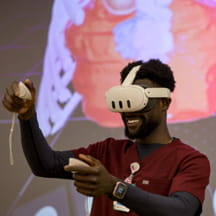Kristin Gist recalls a parent telling her she was "terrified" about her son's upcoming surgical procedure. While it was understandable for a mother to worry about her 4 year old's pending operation, what had kept her awake the past four nights was the fear of how her son—who has autism—would respond to the entire ordeal.
The mom's concerns washed away during the pre-operative visit. The care team at Rady Children's Hospital in San Diego, California, asked her questions from its Autism-Friendly Questionnaire (AFQ), a tool designed to help a patient's care team understand their needs and preferences prior to a hospital visit.
"She said she slept like a baby the night before the surgery," says Gist, advisor for developmental services and Transforming Mental Health. "She knew then that somebody understood."
The day of the procedure, her son's care team came to the waiting room with an iPad playing his favorite cartoon. Following his surgery, a customized recovery room with low lights and very few stimuli awaited him—per his mother's questionnaire responses. The relieved mom told Gist, "This was the best experience on earth."
Questionnaire improves communication, patient outcomes
Rady Children's launched its AFQ in early 2020 to improve outcomes for the roughly 20,000 children it sees each year who are on the autism spectrum. The questionnaire was the culmination of several months of development by a multi-disciplinary task force across Rady Children's and children's hospitals with similar tools, including Boston Children's Hospital, Cincinnati Children's Hospital Medical Center and Children's Hospital of Philadelphia.
The AFQ is used primarily in clinical areas that can be stressful for patients on the autism spectrum—developmental services, surgical services and the emergency department (ED). Parents provide responses to a series of questions about their child, including the best ways to communicate with them, what stimuli may upset them and techniques to make their hospital visit positive. The information is stored in the patient's electronic medical record (EMR), so all caregivers have access to the patient's AFQ.
An airplane icon next to a child's name on the tracking board indicates the patient is on the autism spectrum, so providers coming onto their shifts can easily identify them.
"We put that in place to help everyone slow down and check the chart before they go into the room," says Abbey Hye, behavior analyst. "If you go into the room and start doing vitals and then realize the child has autism and things are escalating, it's too late."
Training, tools and support supplement AFQ
The initiative doesn't end with the questionnaire. Gist and her team conduct training sessions with providers on how to interpret the questionnaire, teach techniques to use with patients and provide access to tools to put those strategies in place.
"Just like a department can order tips for otoscopes or electrodes for an EKG, they now have a list of items they can order to help a child through procedures—things like Koosh balls, Chewy Tubes and Play-Doh," Gist says. "These are tools we use to help keep children distracted through a procedure or reward them for doing a good job by being able to get through a procedure."
Hye spends 20 hours per week at the hospital's ED to provide direct support to emergency care providers using the questionnaire and mitigation strategies to improve the patient experience.
Gist says about 30% of the hospital's autistic patients have a completed questionnaire on file, and the feedback from participating families has been positive. She hopes all these factors will more easily facilitate the hospital's plans to expand the project across the institution.
"Once the staff experiences the positives and the success of the program, it just spreads," Gist says. "Then other teams come to us and want us to train them and provide the same tools."


